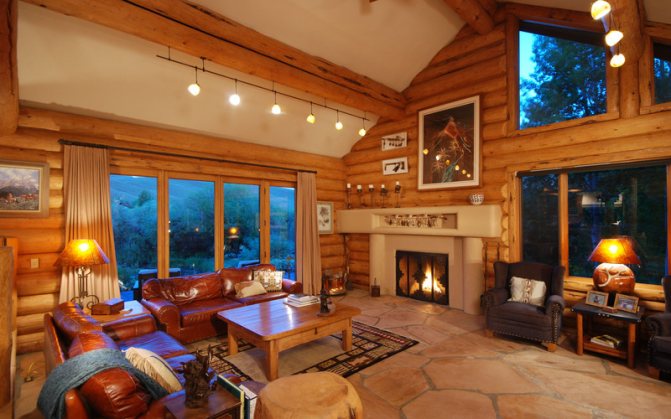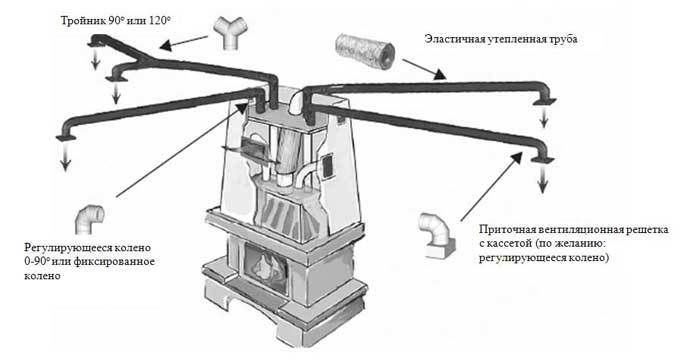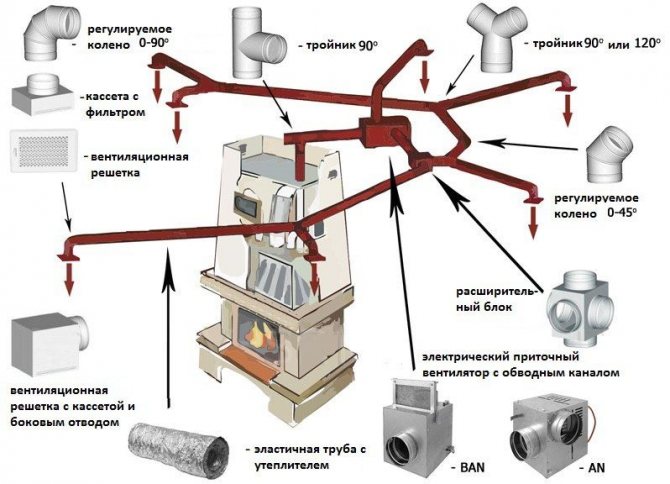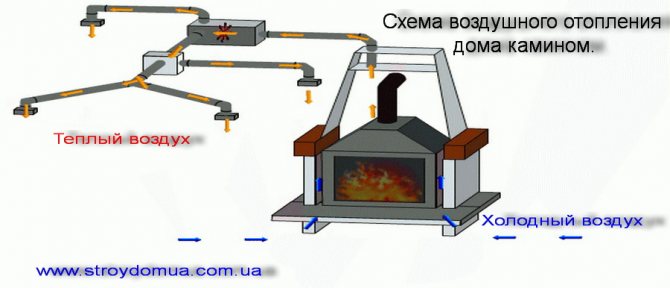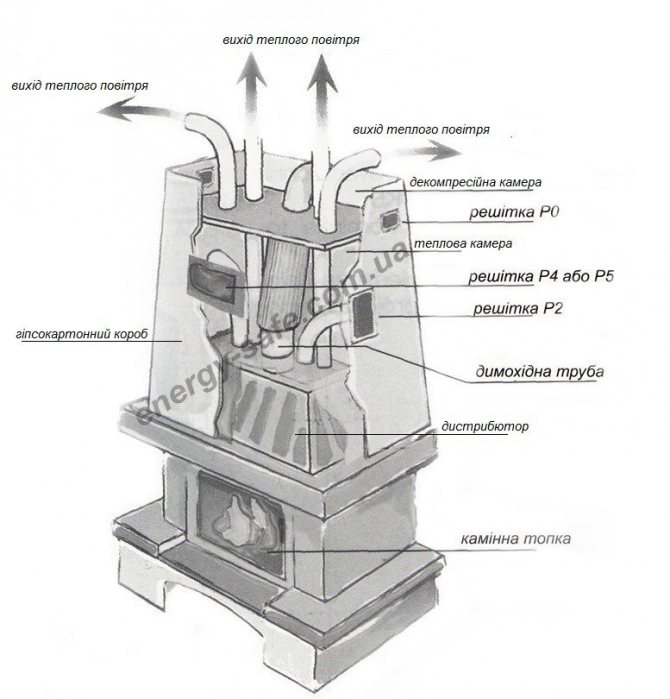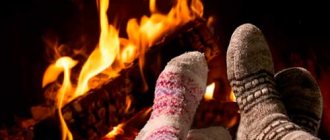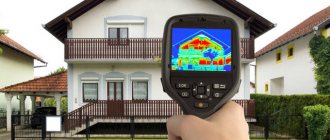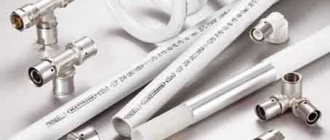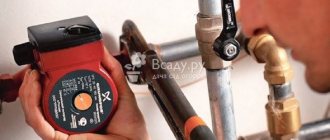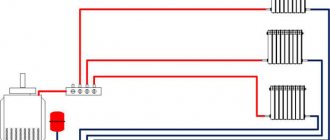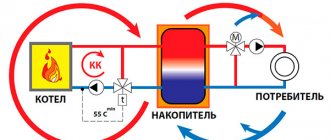Nowadays, a heating fireplace is a very functional, practical and beautiful product. And almost everyone can afford the joy of a real hearth, opposite which one can gather on cloudy evenings, listen to the measured crackle of firewood. A fireplace does not have to cost a fortune, because today models of absolutely any price category are presented on the world market. If you approach the issue of choice correctly, and it is desirable to involve specialists in it, then you can save a lot and become the owner of your own fireplace.
Mistakes when choosing an air-heated fireplace
The generally accepted scheme for choosing heating equipment in this case is unacceptable. Most believe that the power of the firebox is selected for the area of the room at the rate of 1 kW per 10 m2. Time has shown that the choice of a fireplace insert for a country house with air heating requires an integrated approach.
Too powerful gas stoves lead to overheating of the apartment. Residents have to open windows or reduce the amount of fuel used for heating. Frequent temperature fluctuations provoke colds and other unpleasant symptoms - weakness, dizziness and insomnia.

Fireplace area calculation table
How to calculate the required power of the fireplace insert with air heating? Experts advise contacting sales consultants with this question. It is necessary to contact a specialist correctly, that is, with the provision of information on the area of the room, the type of ventilation and the number of rooms. Only in this case the seller will select the required equipment power.
Traditional or wood-fired
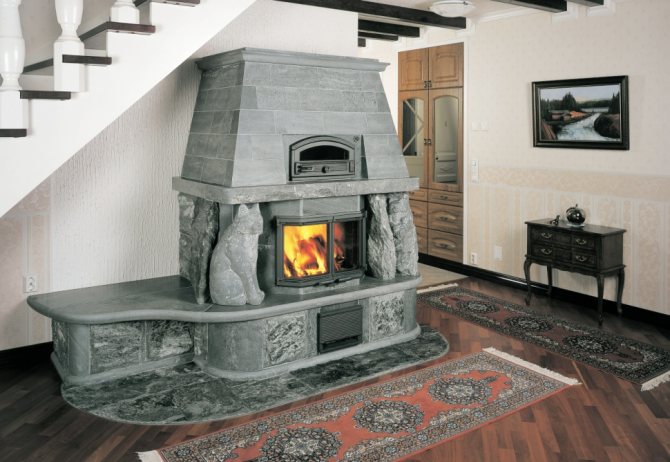

Firewood and coal are used as fuel. For the manufacture of a fireplace used:
- steel;
- a rock;
- cast iron;
- brick.
By type of firebox there are:
- open;
- closed;
- half-open.
We must remember! To make the house warmer, it is better to choose models with closed fireboxes, if you want the appearance to be more attractive, then the open option will be successful.
Bio fireplaces
Decorative type. The fuel used is bioethanol. The main advantage is that you do not need to arrange the chimney. The main role of such a fireplace is to decorate the room.
On the plus side is the fact that the fire is absolutely free of smoke and soot. The price of this type of fireplace depends on the size, design and other factors.
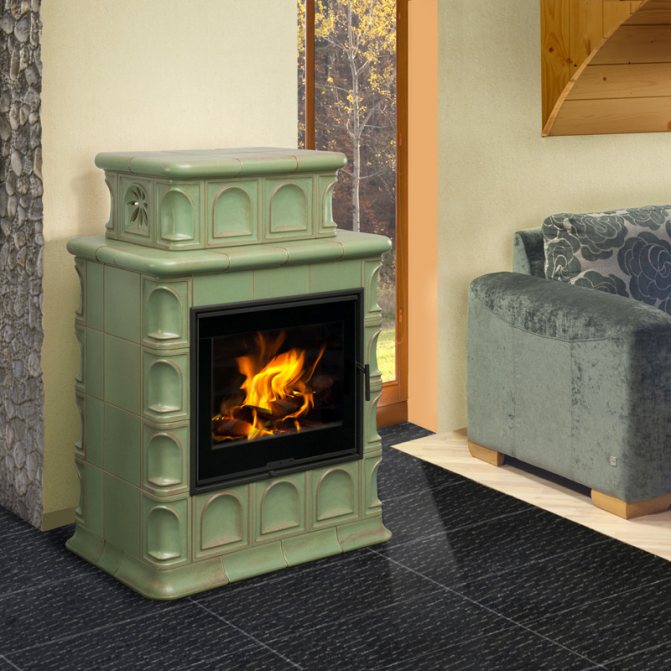

Gas
This type can be installed in country houses when there is gas equipment. In some cases, self-contained gas cylinders are used. Such fireplaces are good as a heating device and as a decorative element of the room.
Electric fireplaces
Today it is the most common fireplace in a country house. They are produced in different shapes and models. Usually used in homes where there is no chimney. The main role is to heat the room.
For country houses, you should choose beautiful models with imitation of firewood, flickering coals, or a flame.
Some models have special controls. With their help, you can adjust not only the heating temperature, but also the lighting and sound, reminiscent of the crackling of wood.
Some features of self-designing a fireplace
The project of the house must necessarily include sections on the construction of the fireplace and its individual elements.
Above the firebox of each fireplace there is its own chimney, the cross-sectional area of the chimney duct of which should be 1/10 of the firebox area. The distance from the junction of the chimney with the combustion channel must be at least 5 meters.
The chimney duct should be equipped with a special damper that will separate the firebox from the chimney, and a hole designed to remove soot that accumulates during operation. The design of the slide damper can be retractable or fixing (using piano hinges).
Average fireplaces can weigh about 500 kilograms or more. Therefore, it is necessary to provide a sufficiently strong and reliable base under the fireplace.
If you have to install a fireplace in an already built house, then you may need to carry out additional work to strengthen the supporting structures.
Air-heated fireplaces
Air heating of rooms and premises with a fireplace provides for heating the air passing between the body of the firebox and its outer surface.


Diagram of a fireplace with air heating. Click to enlarge.
Distribution of heated air in the rooms of the house is carried out using pipeline channels installed in the walls or in the ceilings.
For the installation of air channels, aluminum or steel pipes are perfect.
In simpler schemes, the gravity method is used for air supply, based on different values of the density of cold and warm air.
Fireplace air heating of this type does not depend on electrical energy, but it can be used to heat only a few rooms.
Fireplace air heating of a house with a large number of rooms and a length of pipelines of more than 3 meters should be carried out according to a scheme with forced circulation.
The structure of such a scheme should include a pump that supplies air under the furnace body or above itself.
Forced air circulation can provide high-quality heating of a sufficiently large country house.
When choosing and installing such a scheme, it should be remembered that the air exchange proceeds in a closed cycle.
It is more rational to build a fireplace with air heating in the process of building a house, since otherwise you will have to face tedious and very costly work - punching holes intended for laying air ducts.
Fireplaces with water cloak
The firebox of fireplaces with a water cloak has one significant structural difference - the body of the firebox consists of two layers, between which the heated water is circulated.
A fireplace in your room is not only an interior element, but also a source of heat.
The heated water is supplied to the radiators of the heating system through special pipelines.
The device of a special heat exchanger (coil) in the upper part of the fireplace will provide an opportunity not only to heat the premises, but also to heat water for domestic purposes, the circulation of which will be carried out by means of special pumps.
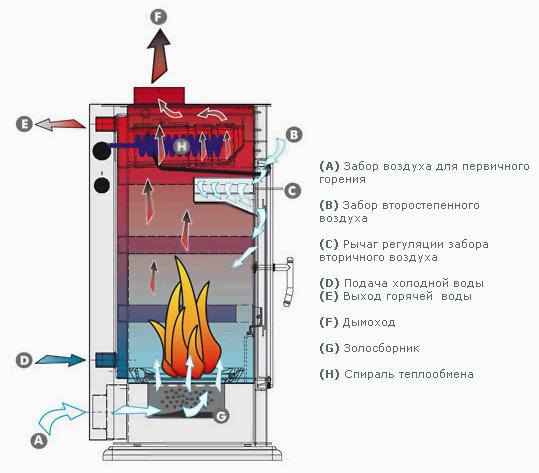

Fireplace frame with water cloak. Click to enlarge.
Manual regulation of fireplaces is possible by increasing or decreasing the air flow into the fireplace insert. Automatic regulation is carried out due to the operation of thermostats with which the pumps are equipped.


7196f3e665317c6c8bc3485445b7def9.jpe ad128a56e9475981dd8e2bebc4210d60.jpe
Thermostats provide automatic activation of the pumps after heating the water to the required temperature.
Self-assembly
It should be noted right away that all the work on organizing the construction of a fireplace with an air duct with your own hands is quite laborious.In addition, the process is subdivided into stages, each of which has its own theoretical basis.
However, this does not mean that independent arrangement of such a fireplace is impossible. In the presence of ready-made projects and the necessary drawings, it is possible to carry out the entire installation with high quality and without significant errors, even with minimal experience in the furnace business.
Many professionals willingly share their best practices. It is recommended to use the ideas of experienced craftsmen proven over the years. A ready-made installation scheme for a corner fireplace for air heating will help a novice master at every stage, starting with the laying of the body itself.
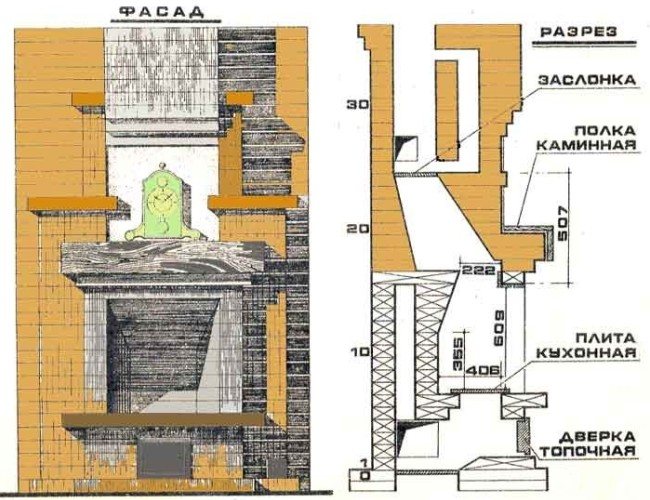

Diagram of a brick fireplace
Choosing a place for a fireplace
The first preparatory stage is accompanied by the choice of the installation site for the future fireplace. Despite the fact that there are many options for a design solution, in this case you will have to be guided exclusively by the practicality of the solution.
For high-quality heating of a house with a fireplace, it is necessary not only to provide the rooms with a duct system, but also to optimize the length of the channels. The shorter the length, the better the circulation will be. Therefore, the fireplace must be installed in a corner to use the maximum number of rooms.
In large houses, it will not be possible to warm up all the rooms, and this will have to be put up with. But in typical layouts, you can always find a room that would border on the maximum number of other rooms.
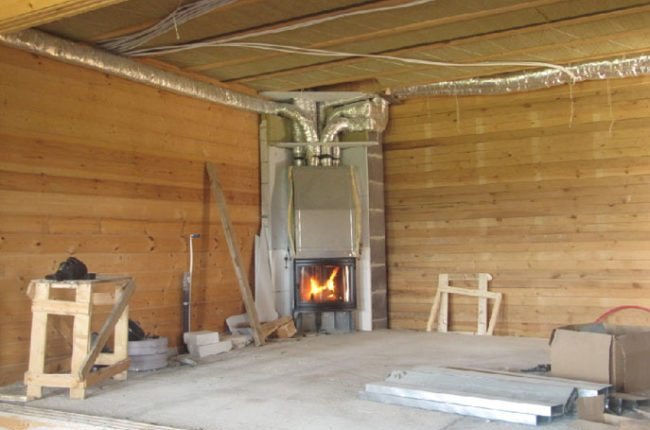

Convenient corner location
Erection of the foundation
In terms of its mass, a fireplace with convection heating practically does not differ from a classic fireplace. The foundation stage will also be similar. The pit is dug so that its depth is 60-70 cm. Depending on the chosen project, fireplaces can have a podium or a rectangular body, like in English styles. This will affect how much of the foundation to perform. Its boundaries should exceed the dimensions of the fireplace by several centimeters.
Good to know: How to properly insulate a fireplace, why you need thermal insulation
To fill the foundation, sand and crushed stone will be required. But sometimes the pit is filled with concrete blocks. All this creates a reliable support for the fireplace. As a mortar, you should use a masonry compound in a 1: 4 ratio of cement and sand. The height of the foundation must correspond to the level of the floor covering. All other construction work must be suspended for the solution to solidify completely.
Wall masonry
Having made a layer of roofing material on the foundation, you can start laying the fireplace itself. To take into account the presence of all nodes and heating ducts through which the air will pass, the masonry should be carried out in separate rows according to a strictly defined pattern. This principle is independent of work experience. Even professionals carry out such actions with the difference that they remember many schemes by heart.
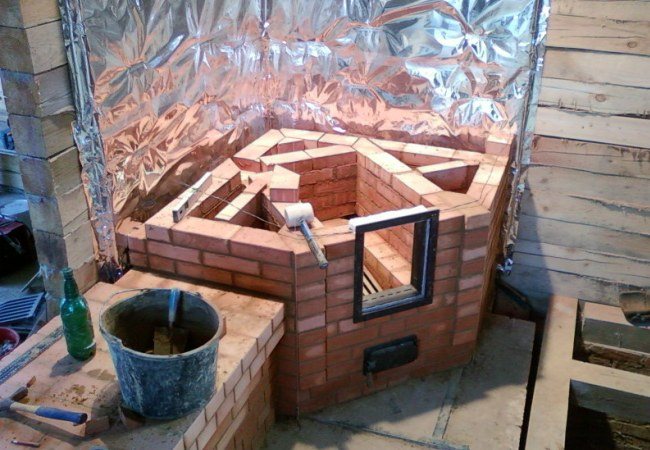

Direct construction of the fireplace
Some fireplace options provide for the formation of a brick firebox. But there are popular models in which a metal firebox in the form of a cassette is built into a brick portal. Measurements show that options with metal fireboxes have a slightly higher efficiency than with brick ones. However, the difference is so insignificant that everyone chooses a suitable performance based on their own ability to pay.
Installation of air ducts
In the place where the air ducts pass through the walls of the room, the air temperature is not as high as in the firebox of the hearth. But it is still necessary to provide security conditions. The contact points of the duct and wall finishing materials are insulated with mineral wool.
The very same line is made of bricks when building a house or from a flexible metal pipe. The task of the master is to heat-insulate this line so that the air retains energy for as long as possible during transportation.You can hide the duct using a drywall box. For this, a frame is made of a metal profile and sheathed with sheets of heat-resistant plasterboard. In some cases, air ducts are made inside the wall.
A well-installed heating system allows you to effectively heat the whole house with a fireplace, thus it is possible to combine decorative qualities and technical capabilities.
Heating circuit
House heating can be carried out using units of different categories. Intermittent combustion fireplaces with a single laying of firewood provide a room with heat for up to a quarter of a day.
Continuous burning devices with an equal amount of fuel increase this period to 8 hours. Even at the minimum power, the amount of heat produced will fluctuate from 3 to 6 kW. High heating levels are achieved with wide open air blowing. At the same time, depending on the design, from 2 to 4 kilograms of firewood will be burned per hour.
The power with which heating fireplaces will work can be calculated based on the size of the heated room. In a room with a ceiling height of 2.8 meters, 1 kW of heat is enough for heating 10 m2 of area. Accordingly, with a power of 10 kW, such an oven will be able to serve 100 m2 of area.
Air
When energy is transferred from one medium to another, the amount of transferred heat is significantly reduced. A properly designed air-heated fireplace can solve this problem due to the small number of thermal transitions. Its device involves burning fuel in a separate chamber, heating the metal part of the furnace and the air inside the room. In this case, the transfer of energy is carried out using flexible heat-insulated channels connected to other parts of the residential building.
Air flows can move naturally or be driven in the desired direction by a forced injection system. With a vertical orientation, a normal air flow is sufficient for high-quality heating. If the location of fireplaces with air heating is far from the premises to which heat must be supplied, it is recommended to install special fans.
Water
If there is an ordinary wood-burning unit in the house, you can connect a heating system to it and achieve a good result in terms of thermal efficiency. Inside the fireplace of this design, a water circuit is installed, connected to the general heating communications of the dwelling. Burning firewood in its firebox increases the temperature of the coolant in the pipes and, due to this, provides high-quality heating of the entire building. The two main connection schemes imply the operation of open and closed systems, respectively.
To install a fireplace in the house and connect an open heating to it, you will need to hang an expansion tank above it, which works on the principle of communicating vessels. With the closed method of connecting the furnace, a common tank is used in the structure, and a separate expansion tank is not built in.
What is a fireplace?
A fireplace is a type of stove that generates heat by burning solid fuel. The classic option is firewood, like a regular wood-burning boiler, but you can heat the fireplace with coal, and special briquettes or pellets. The fuel is burned due to the air draft generated by the fireplace structure. The blower duct provides cold air to the main chamber, where combustion takes place. The smoke goes into the smoke collector, and then is removed through the chimney, providing sufficient traction for the active combustion of firewood. The resulting heat is distributed throughout the house, depending on the design of the fireplace.
The fireplace consists of four main parts:
- Portal. This is the external, frontal part of the fireplace, which carries both a constructive function and a decorative one.It can be made of brick, natural stone, marble, artificial stone. The portal is decorated with various decor, it can be made in any style that suits the interior of the house. The upper part is used as a mantel.
- Firebox. This is the central part of the fireplace, a chamber in which fuel is burned and heat is generated for heating. For the manufacture of the furnace, refractory metal or heat-resistant bricks are used. It can be open or have a door.
- Haylo (smoke collector). Needed only for fireplaces with an open firebox. It is a special chamber where smoke is collected before entering the chimney.
- Chimney. A vertical pipe for removing smoke outside the house, providing traction for active combustion of fuel in the main chamber of the fireplace.
The fireplace has several varieties, each of which has its own design features, and therefore, fireplaces are classified according to several criteria.
Chimney arrangement
After the "body" of the fireplace is ready, you can start creating the chimney. Its passage must correspond to the calculated value. From above, the chimney should be reliably protected from precipitation. For these purposes, you should use a wide smoke hood made of galvanized sheet metal.
There is no better material for a chimney than red ceramic brick. Here is what one of the participants of our forum thinks about it.
The advantages of a brick chimney are considerable. It is much more difficult to achieve the formation of condensation in a brick pipe than in a sandwich - you have to try. The combustion of soot is not scary, the heating of the outer surface of the pipe in the attic is minimal or even completely invisible. The durability of a properly folded brick pipe is many decades.
A galvanized pipe made of heat-resistant steel can be used as a chimney. Such a chimney is made multi-layered (as a result, a kind of "sandwich" is obtained), on three sides it is closed with plasterboard.
During those periods when the fireplace is inactive, any chimney becomes the cause of drafts. In order to avoid such a harmful phenomenon, special valves (gates) are mounted in the chimney shaft. They open only when the firebox "comes to life", filling the room with pleasant warmth.
The cross-sectional area of the cylindrical chimney with the area of the fuel portal must have a ratio of 1:10.
Particular attention should be paid to the height of the outer part of the chimney:
- if the gap from the ridge to the chimney is less than 1.5 m, then the chimney must be at least half a meter higher than the ridge;
- if the distance from the chimney to the ridge is more than 1.5 m, then the upper cut of the chimney should not be lower than the level of the ridge.
Advantages, disadvantages
The positive qualities of the units include:
- the principle of operation of a simple fireplace model: the release of heat energy of the stove occurs during the process of fuel combustion;
- chimney ducts are designed to remove carbon monoxide. If you additionally provide for channels through which air will move convectionally, the temperature marks will become higher;
- there is no localization of heating zones near the fireplace;
- simplicity, ease of the heat carrier air circulation system;
- high level of security. Compared to a water circuit, even the smallest hole in the piping can cause a rupture. Hot water can cause burns, greatly harm a person;
- lack of heat carrier;
- lightness, simplicity of turning on, turning off the heating;
- in comparison with the water circuit, it is significantly cheaper;
- no temperature drops across localization zones.
Negative sides:
- the cost of organizing the system. Constant fuel filling;
- fuel cost.
Dignity
Let's consider the main advantages of fireplaces with convection heating, and then move on to the device.Heating systems with air circulation have a whole list of advantages over a classic fireplace, we will highlight only the most significant of them.


Household heat distribution diagram
- Heat transfer by means of radiation is completely stopped when the fireplace is stopped. When a fireplace with a convection heating principle goes out, the air continues to circulate for a while, heating all rooms. This fact contributes to fuel economy and efficiency increase.
- Due to the fact that air is used to heat the house, it is possible to increase the efficiency of the fireplace due to additional heat exchange not only in the area of the firebox, but also in the chimney.
- Air circulation implies the flow of new portions from the outside. This provides additional ventilation in the room.
- Compared to water heating, where the transfer of energy is carried out in two stages, the air heating circuit transports directly the heat carrier, which will fill the room.
- The presence of fans, which participate in the circulation of the coolant, increases the length of the ducts with air ducts up to 10 meters.
It is necessary to think about the possibility of installing a fireplace when erecting walls. Firstly, the construction of the foundation for the fireplace is easier to carry out when there is no floor covering yet, and secondly, the routing of the air ducts requires partial destruction of the walls. During their construction, you can immediately supply the rooms with channels.
Output
Fireplaces are one of the oldest ways to heat a home. However, using additional equipment built into them, it is possible to provide comfort and warmth throughout the house.
The main thing is to correctly perform all engineering calculations and construction work. You can learn more about this from the video below. And if you have any questions - ask them in the comments, we will be happy to help you solve the problem.
Did you like the article? Subscribe to our channel Yandex.Zen
The device of a classic brick fireplace
Strictly speaking, open hearths are not very suitable for heating private cottages due to the low efficiency of burning firewood, the efficiency is only 20-30%. While a fire is burning in the firebox, heat is spread throughout the room by means of infrared radiation. After damping, the intensity of heating decreases and stops after 2-3 hours, when the brickwork has cooled down.
Despite their low heat dissipation rates, fireplaces remain attractive to homeowners as they create a unique home-like environment. The device of a classic English hearth is shown in the diagram and includes the following elements:
- underground part - foundation;
- base of 2-3 rows of bricks;
- bottom part with forward-protruding furnace platform;
- portal - brick framing of an open firebox;
- smoke collector - an upward-tapering channel in the form of an umbrella above the combustion chamber;
- the chimney tooth at the beginning of the smoke collector serves for better heat extraction from hot gases;
- chimney leading to the roof;
- traction force is regulated by a slide valve.
Diagram of the device of a classic open hearth
If the construction budget allows, then outside, the walls are tiled, as is done above in the photo. It is not necessary to decorate the walls of the structure - the correct brickwork looks quite neat.
a7ab4a51a9a07018fb67959eed591a6c.jpe
It is interesting: Marble portals for fireplaces - we learn from all sides
Principle of operation
Factory models of heating boilers for such fireplaces have a heat exchanger around the body in the form of a spiral or a radiator made of thin pipes through which water or air circulates. When heated, they flow through the heating pipes to the radiators in other rooms.


A wood-fired fireplace with a water circuit has a low efficiency, not exceeding 60%. In addition, simple models require a constant supply of firewood to efficiently supply the house with heat.Pellet fireplaces are relieved of these problems. They use pellets as fuel, which have a higher specific heat of combustion than wood. The pellet is automatically loaded from the back of the firebox. The intensity of the feed and, therefore, the power of the fireplace can be controlled using the electric control panel.


Fireplaces with an air duct can have an efficiency of up to 80%. Complex models can be designed with a heating function in the firebox and in the wall. This achieves maximum heating of the circulating air. Unlike water circuits, air systems require fans, which requires additional wiring and more energy consumption. But on the other hand, pipes for them are less demanding on strength, most often they are made of thin and cheap aluminum.


For safety, most fireplaces with air and water circuits are equipped with a fireproof glass protective door. Heat penetrates the room through this glass due to infrared radiation. This eliminates the possibility of sparks entering the room, and the owners can enjoy the sight of a bright flame. A soot protection is provided to keep the glass shutter clean.


Gas heating in a private house


Today, gas heating has gained great popularity, since for little money it can warm up the entire space of a large dwelling. In the heating process, fuel is burned and converted into heat energy. Similar heating options can be seen in many residents of suburban settlements. Thus, you can quickly heat up the living space, the equipment is easy to install and, moreover, the gas itself is an economical fuel. Among other things, during the operation of the installation, they do not generate noise vibrations, they work quietly and efficiently. The gas heating system includes a boiler and a heat carrier. The cheapest option for a coolant is ordinary water, and in winter you can use antifreeze - an anti-freeze liquid.
Gas boilers are divided into single-circuit and double-circuit
.
What is the difference between these two types? The first option (single-circuit boilers) is used only for heating water, and the second (double-circuit installations) is also used for obtaining hot water and heating the room.


The heating system is also divided into two more types. Thus, it is possible to heat the dwelling using a gas cylinder and by connecting to the mains. Of course, in the first case, the costs will be an order of magnitude higher, since the cylinder will need to be refilled from time to time. In the second case, you will have to constantly monitor the pressure in the boiler room.
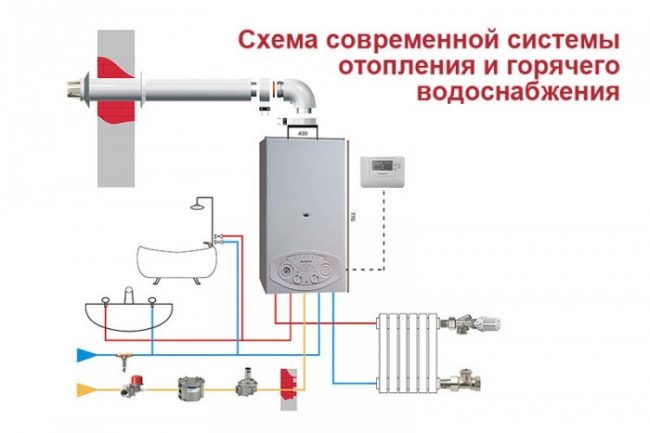

According to experts, boilers operating from the mains are considered more environmentally friendly and powerful. When comparing gas to other fuels, it usually has no equal. You can choose, in order to heat a suburban home, you can use both types of boilers.
Air ducts - device features
As well as for laying the firebox, brick or metal is used when arranging the ducts of the air supply system. You can also use special flexible pipes that can be bought here, but they are recommended only for short sections, as they interfere with the movement of air. Failure to comply with this condition will require the installation of more powerful fans, which will increase the cost of your fireplace.


Do not forget about the thermal insulation of the channels. This will not only reduce heat loss, but also increase the safety of the entire structure. For high-quality air movement (minimizing air resistance):
- provides the most even surface of the inner part of the channels;
- the number of bends in the system is reduced;
- large straight channels are laid;
- a fireplace with an air duct is connected by separate channels.
Thus, a fireplace with combined heating allows you to quickly heat the premises of the house, has a simple device, is safe and has a low price. However, you will have to work a little in the field of cleaning the chimney and firebox, to attend to the arrangement of the place for storing firewood.
Features of the air vent ducts
Brick is usually used as a filling material, it also serves for the construction of channels for the removal of air flows. Metal as well as flexible pipes can be used as an alternative type of material. Nevertheless, such innovations can somewhat impede air traffic, which is why they are recommended to be installed only in small areas. If flexible pipes are installed along a large perimeter, then this problem can be solved by installing an additional number of fans with higher power, which in turn will affect the cost of the entire fireplace installation.
In addition, the level of thermal insulation of the channels is considered an important factor, since this allows you to simultaneously reduce the loss of thermal energy and increases the safety level of the entire heating system.
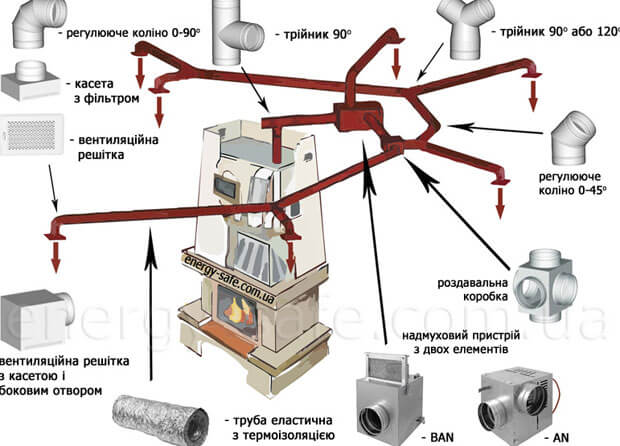

In order to minimize air resistance and ensure its high-quality circulation, it is necessary to keep in mind that:
- When erecting the entire structure, it is worth strictly observing the maximum evenness of the surface, both outside and inside.
- The number of bends around the entire perimeter of the air vents should also be kept to a minimum.
- Direct routing of large diameter canals will also be a crucial step.
- The fireplace should be connected to the air outlet using separate ducts.
Taking into account all of the above, it can be noted once again that combined heating systems are distinguished by their particular efficiency, safety and low cost. Nevertheless, even with the acquisition of such a structure, unfortunately, it will not be possible to avoid constant maintenance and cleaning of the chimney. This also applies to the storage space for fuel wood.
Features of the stove device
Refractory brick dimensions
It has been proven above that air circulation is much more efficient than traditional fireplace heating. High efficiency rates are maintained due to the special design of the stove. It is worth noting that gas fireplaces differ little in the design of stoves.
A cassette fireplace is the most demanding design for the correct arrangement of the stove. For its arrangement, builders use only refractory bricks or metal structures made of cast iron.
Cast iron stoves are considered the most heat-intensive and efficient heating devices.
Fans are located above the stove. Practice has shown that heating the house with a fireplace depends on their reliability. Therefore, experts recommend choosing only fire-resistant fans if you plan to install them yourself.
As for decorative elements, their presence is optional for a private house. Nevertheless, summer residents are actively buying fireboxes with decorative elements with glass doors, modern opening mechanisms, etc.
When choosing a stove for a fireplace in a country house, special attention should be paid to the power of the device, which can be determined in the technical passport. The power of the stove grows with its size
Experts came to the conclusion that it is better to buy stoves 10-15% more powerful than the equipment requires.


The scheme of heating the air in the fireplace
Separately, it is necessary to note the closed stove. The closable structure additionally increases the power of the entire structure due to smoldering, which is provided by a closed door. As a result, not only the power of the equipment increases, but also the economy of the consumed fuel increases by reducing the air supply. Thus, a closed firebox is an efficient and economical equipment for space heating.
The history of the fireplace heating system
When using the word ‘fireplace’, many people associate it with an installation with an open firebox, which everyone is used to seeing in many photos and illustrations in magazines. However, such designs, although they make a reference to antiquity, do not differ in high efficiency rates.
This disadvantage is caused by the technical features of such a system, since the energy generated during combustion goes nowhere, the reason for which is:
- poor insulation of the firebox;
- lack of ability for air to move;
- small depth of the firebox.
As a result of these problems, the room is heated by heat from a fire, and not by air or convection. That is why it will be warm in the room only if the fireplace for heating the house is constantly kept active. In addition, the main heat energy under such conditions is distributed only in front of the fireplace, and not on the sides. Experts estimate that the efficiency of such an installation is about 15 percent, which makes it not a very reasonable waste of money.
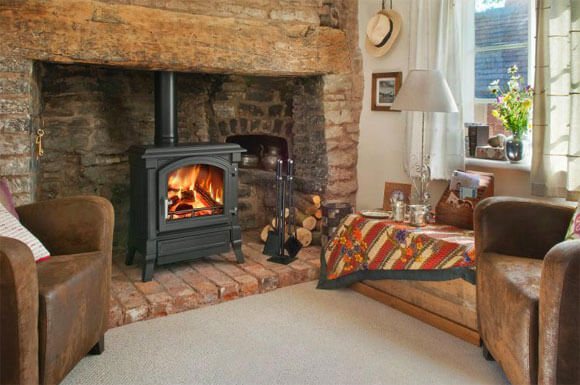

Almost since the invention of the fireplace, builders have constantly tried to improve it. To begin with, they were equipped with air heaters, then chimney channels were installed, which, as a result, became the reason for the appearance of a fireplace stove. However, it is only possible to improve the efficiency of up to 80 percent of lard with the invention of such a system as air heating with a fireplace.
These innovations gained the greatest popularity in England, since most of the houses were heated with a fireplace. It is no coincidence that it was England that became the place for testing all kinds of innovations, for example, many rooms with the same parameters were selected, and then the data obtained on the level of heating and fuel costs were analyzed.
Thanks to such studies, it was revealed that it was precisely systems with an air duct that consumed less fuel and at the same time gave more heat energy, and the difference was in many cases twofold. So, with the old indicators, 65 m3 / h of air was needed in order to heat the room, while after the installation of these innovations, these indicators increased to 200 m3 / h.
Which is better: a fireplace with a water circuit or with air ducts?
This question cannot be answered unequivocally. The advantages and disadvantages of both systems come from the characteristics of the heated room, the desired temperature regime in the rooms.
Heating fireplaces with a water circuit have the following advantages:
- efficiency;
- low cost;
- the contour of the fireplace can be easily integrated into the existing heating system of the house;
- the possibility of preparing hot water;
- low cost of equipment;
- low price of energy carrier.
A heating fireplace with a water circuit has disadvantages:
- low efficiency;
- the need for constant loading of the energy carrier;
- manual mechanism for adjusting the intensity of work.
If we compare fireplaces with open and closed combustion chambers, then the efficiency of the first is 20%, and the second is 70%.
A fireplace with air heating with your own hands is the easiest to make, because the equipment is not distinguished by a complex device. The very layout of the air ducts is also easy to organize. The room temperature is reached within a few minutes.
Disadvantages of a fireplace heating system with air ducts:
- constant circulation of dust in the house due to the operation of fans (in the case of forced air circulation);
- increased noise level due to air movement along the air ducts;
- the temperature in the room drops as quickly as it rose after the extinction of the fireplace;
- low efficiency;
- the need for manual control of the combustion reaction;
- the need for constant loading of the energy carrier into the furnace.
Heating a house with a fireplace with a water circuit and air ducts can be an excellent alternative source of heat, but not the main one. Such heating elements run on an inexpensive energy source. But fireplaces can be afforded by those people who are not too lazy to constantly throw firewood into the firebox, control the intensity of their combustion and periodically clean the chimneys.
How are fireplaces with air ducts arranged?
A fireplace with air heating is simpler than similar equipment, but with a water circuit. That is why making the first option in artisanal conditions is much easier than making a do-it-yourself fireplace with water heating. This explains the popularity of the air circuit in private houses. Such wiring acts as an excellent alternative way to heat a room when the main (gas or electric boiler) has ceased to function for some reason.
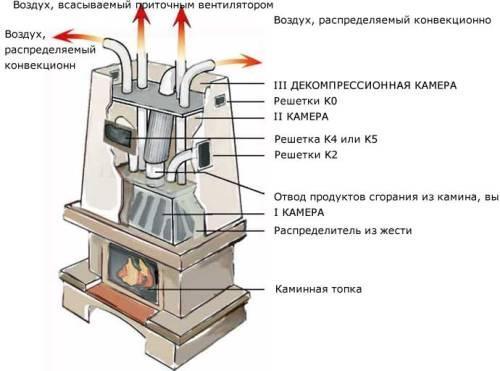

Air heating method.
Fireplaces for air heating of a house are similar in structure to their counterparts with a water circuit. The process of removing combustion products from the system is of interest.
Chamber I. It is located under a metal convector. It is equipped with a fan that supplies hot air. The latter comes from the combustion zone. Chamber I is equipped with a series of pipes. They are mounted to the side walls of the fireplace chimney. These tubes end with valves. Such a device is necessary if the electricity is cut off and the supply ventilation stops working.
Camera II. Through it, cold air is drawn through the side grilles-fans of the outer shell of the fireplace. Cold air is heated by the metal body of the heating element and pipes through which the combustion products are removed. The chimney can be heated up to 700 ° C. It is in it that the final combustion of the gas formed as a result of fuel combustion and solid particles occurs.
In order to significantly increase the heat exchange between the chimney and the cold air entering chamber II, the surface of the former is increased by means of ribbed hoops. Also, the chimney is equipped with a damper. With its help, it is possible to mechanically regulate the draft in the fireplace, and, consequently, the intensity of combustion. From chamber II, warm air is either evenly distributed in the space near the fireplace through special holes, or enters the air ducts, which diverge from the heating element throughout the house.
Any home-made device is inferior to factory equipment in terms of efficiency and efficiency. That is why you need to trust the manufacture of fireplaces to specialists who have the appropriate education and experience in this field.
Camera III. Decompression chamber. It is necessary so that heating by a fireplace with an air duct is safe. It plays the role of an insulating space between the ceiling of the house and the hot chimney.
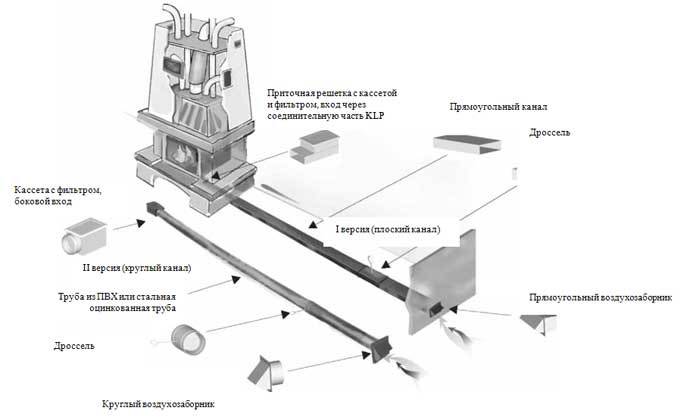

Air-heated fireplace piping.
How does a fireplace work?
The principle of operation of a fireplace with air ducts is based on the correct supply of fresh air from the outside and the timely removal of combustion products.
The air supply to the fireplace can be done in two ways:
- directly from the living quarters;
- using an air duct from outside the house.
The first method is easy to install. To do this, it is necessary to correctly calculate the area of the room where the fireplace is mounted, according to the power of its combustion chamber. So, for the combustion of 1 kg of wood, 8 cubic meters of air is needed. Based on this, it is easy to calculate that a heating element with an average power should be installed in a room with a cubic capacity of at least 30 cubic meters. Otherwise, unfavorable conditions for human life and even an emergency situation are created in the house.
The advantage of the second method is that there is no relationship between the power of the equipment and the cubic capacity of the room where it is installed.In this case, combustion air is taken from the street. For this, round or rectangular air ducts made of galvanized steel or PVC material are laid under the floor in the house to the fireplace. At the end of the pipe facing the street, there should be a grill. It protects the air duct from rodents and insects. Filters are also important in this case. They are designed to clean the supplied air from dust. They are installed in the valve directly in front of the fireplace.
Combined heating
Combined heating is said when the fireplace gives off heat not only by radiation from the flame, but also from heating the air inside itself. If everything is clear with the heat from the flame, then what is meant by heating the air in the fireplace?
In this case, the increase in air temperature is carried out in special channels located between the furnace cavity and the facing material of its walls. Warm air enters the room through the channels in the walls or ceiling. In order to avoid mixing it with combustion products, the latter are discharged through the chimney.
Heated air can enter the air ducts in the walls:
- By natural convection. It is achieved due to the difference in the density of cold air and warm air.
- Forced convection. In this case, air is pumped into the ducts using fans.
With the help of control systems, it is possible to control the power of these fans and, as a result, the distribution of heat in the house.
The design of air ducts must be carried out in the process of working on a project at home. In this case, you can foresee a lot of nuances in the work of the future fireplace, including the type of fuel used.
The efficiency of the air duct system is based on some fundamentals that are known only to specialists, which are recommended to be consulted. So, the greatest efficiency from a fireplace can be achieved by the device of a simple channel system, its centralization.
Those who are worried about the cleanliness of the air in the house should be aware that it is best to use fresh air to operate the fireplace. Otherwise, the following unpleasant situation will develop: polluted air from the fireplace room will enter the heating system, and under the influence of high temperatures it will return back in an even worse condition.


The scheme of the fireplace with air heating
How does it work
To fully appreciate the efficiency of an air-circuit fireplace, you will have to consider the principle of heat transfer in a classic fireplace. As you know, there are three ways to transfer thermal energy. The thermal conductivity of air is rather low, so this method has never been considered as dominant.
The advantages of convection have not previously been objectively assessed, so the key stake was placed on radiation. A classic fireplace with an open firebox did not even heat the air in the room, but the surrounding objects, and those, in turn, transferred heat to the air and the room warmed up. However, one could not even dream of transferring heat to other rooms.
Over time, the transfer of matter, as a way of transporting energy, became more and more of interest to furnace masters. Modern air heating from a fireplace is based on the fact that heated air is carried around the rooms. In the design of such a fireplace, two main tasks are implemented:
- efficient heating of air masses;
- their transmission over a distance.


Air heating system operation diagram
Hollow channels, which are arranged in the fireplace body between the firebox and the outer wall, help to cope with the first task. They can be made in the form of a labyrinth in order to increase the area of contact of air with the heated walls of the furnace.
Good to know: Vacuum cleaner for cleaning the fireplace and stove, the main differences from the household counterpart
The Russian stove in the chimney area is arranged in a similar way. Only tap transfer of heat is carried out from the hot air to the walls. The air from below enters the channels through special openings and heats up. Convection currents move upwards and the air temperature rises even more during the movement. Natural convection alone is not enough to move air through winding channels. It is necessary to use fans that pump new portions of air and displace the heated masses, which provide heating of the room.
The second task is realized by distributing the air duct in the rooms. Warm air flows through the ducts to the neighboring rooms. If the length of the duct does not exceed 3 meters, then natural convection is used for transportation. Otherwise, forced circulation is ensured.
Project number 1 - compact mini-fireplace
This hearth is suitable for heating a room of 16–20 m² in a country house or a small country house. Another option for using the structure is as a street barbecue built in a garden gazebo. The feature of the fireplace is lateral convection ducts that heat the air in the room. The size of the building is 102 x 51 cm.
To lay out a mini-fireplace, you will need the following materials:
- solid ceramic bricks - 240 pcs. (chimney is not included);
- revision door 24 x 14 cm - 1 pc .;
- cast iron grates 18 x 14 cm;
- latch 25 x 14 cm;
- stainless steel sheet 1 mm thick, size 500 x 1000 mm;
- a sheet of black or galvanized metal, laid in front of the firebox, dimensions - 70 x 50 cm.
Sectional drawing of a mini-fireplace. Convection channel outlets are provided on the side walls
The mini-fireplace shown in the drawing is laid out in this order:
- The first tier is solid. On the second, 3 air channels are laid - 2 side and one in the middle, located under the grate.
- On the third row, the bottom part and the nest of the grate are formed (made 5 mm wider than the product). Then the grate itself is placed.
- A fireplace insert is being built from the 4th to the 10th tier. On the V row, 2 metal rods Ø5 mm are laid for mounting a stainless steel sheet.
- In the 10th row, the rear brick protrudes a quarter into the firebox, the side stones move outward by 40 mm. The width of the firebox in this place is 49 cm.
- The ends of the side stones of the 11th tier are sawn at an angle of 28 ° to the vertical line. You will get the support platforms of the arched vault. 2 stones in the depth of the firebox are placed on the edge.
- The vault is constructed of 9 stones, cut in the form of a trapezoid, with base sizes of 65 and 52 mm, as indicated in the order. The radius of the circle is 51 cm.
- On the 12th tier, the formation of the vault is completed, the upper steel rods are placed and a stainless steel screen is installed.
- Tier 13-14 forms the outlet openings of the convection channels. The inspection door is installed here.
- 15th row - the overlap is being built, 16-18 - the beginning of the chimney.
The master will tell in detail the algorithm for laying a mini-fireplace in his video:
Project # 2 - simple heating fireplace
The dimensions of this structure are 112 x 65 cm, height - 2020 mm. The inner size of the portal is 52 x 49 cm. Accelerated heating of the room is provided due to the convective air channel. The building materials kit looks like this:
- clay corpulent brick - 345 pcs.;
- chimney valve - 250 x 130 mm;
- 2 steel equal angles 45 mm wide and 70 cm long;
- metal sheet 500 x 700 mm.
A feature of the masonry of the fireplace shown in the diagram is the setting of a large number of bricks at the base on the edge. Above, a narrow long channel is arranged, where the heated air of the room moves. Let's move on to the construction algorithm:
- The first tier is solid, consisting of bricks put on the bottom. On the second tier, a heating duct with a section of 65 mm is formed, on the third, the base of the firebox is laid.
- From the 4th to the 9th rows, the walls of the portal are being erected.The air duct moves to the inside of the back wall of the fireplace. On the 9th tier, corners are placed - floor supports.
- Tier 10 - overlapping the firebox. On the 11th row, the front stones are extended by 130 mm, the 12th tier is a mantelpiece. The convective channel is divided into 2 narrow shafts.
- Rows 13-25 make up the smoke box. The heating channel ends in the 14th tier.
- Row No. 26 closes the flue, which tapers to a chimney. The gate valve is installed on the 27th tier.
- The remaining rows 28-31 form the beginning of the chimney.
The technique of the trial kindling of the fireplace is demonstrated in the last video:
Masonry
Layout of rows for a corner fireplace
Cover the dried-up foundation with a double layer of roofing material. This will provide the necessary protection for the foundation.
Prepare masonry mortar. Traditionally, fireplaces are laid out using a pre-soaked clay mortar.
The first row of masonry is best done using a mortar with a small addition of cement (approximately 10-20% of the total mass of the mixture).
Calibrate the bricks in advance by selecting the most suitable sized products for the masonry of each row.
Immerse the bricks in water for a while before laying. This will allow the items to become saturated with moisture. Otherwise, the bricks will take water from the clay mortar, which will lead to a significant deterioration in the quality of the masonry.
Lay out the first row of bricks with an edge. Check the alignment of the row with a square and a level. Make sure opposite sides and diagonals of the base are the same length.
The recommended seam thickness is up to 0.5 cm.
The laying is carried out in accordance with the order. The following is a procedure that is relevant for most existing types of fireplaces. For the rest, be guided by the drawings you have.
Fireplace laying, step by step instructions
Lay out three continuous rows of the base.
Fireplace laying, step by step instructions
Second step
Lay out 4-5 rows with an ash pan arrangement.
Fireplace laying, step by step instructions
Third step
Lay out 6-7 rows with the arrangement of the bottom and frame of the brick fireplace.
Fireplace laying, step-by-step instructions Fireplace laying, step-by-step instructions Fireplace laying, step-by-step instructions
Fifth step
Lay out rows 14-19 with the arrangement of the smoke box.
Fireplace laying, step by step instructions Fireplace laying, step by step instructions Fireplace laying, step by step instructions
Sixth step
Lay out 20-25 rows of fireplace with chimney arrangement.
Arrange the basement and continuous rows of masonry using a trowel or trowel. The chimney and fuel chamber are laid out manually, because
at these stages it is very important to control the quality of the solution used
Apply the masonry mortar to the middle of the bricks. The edges of the elements must remain free.
When laying out each row, adhere to the selected order. For more convenience, you can number the products.
Pay special attention to the quality of the masonry of the fuel compartment and flue ducts - these elements must be laid out as evenly and as tightly as possible. Laying a fireplace, step by step instructions Laying a fireplace, step by step instructions Laying a fireplace, step by step instructions Laying a fireplace, step by step instructions Laying a fireplace, step by step instructions
Laying a fireplace, step by step instructions Laying a fireplace, step by step instructions Laying a fireplace, step by step instructions Laying a fireplace, step by step instructions Laying a fireplace, step by step instructions
To form a beautiful curved vault, gradually overlap the masonry elements.
It is important that the size of the overlap does not exceed 50-60 mm in each row.
Arrangement of curved lintels is performed using temporary formwork - circled. To fix such a formwork, use the supports under the equipped fireplace arch.
Start with a brick in the center and work symmetrically in both directions.
Periodically check the verticality of the flue pipe. Even the slightest deviations from the vertical can lead to the appearance of smoke in the room.
Fireplace laying, step by step instructions
For laying the chimney, use a mortar with the addition of cement, similar to the mixture used to lay out the fireplace base.
The chimney must be covered with a layer of fireproof insulation to increase fire safety. Insulation is installed in the places where pipes pass through the structures of the house (floors, roofs, etc.). The most commonly used insulation materials are asbestos.
Fireplace chimney
Types of fireplaces by material of manufacture
For the device of aquacamine, brick, natural stone, ceramics, cast iron, steel sheet, basalt fiber insulation, heat-resistant glass are used.


Brick
The fireplace stove can be custom designed for almost any configuration. Tiling will emphasize the individuality of the interior. As a rule, high quality working bricks (refractory) are used in such fireplaces.
Requires careful adherence to technology, high-quality installation. Installed on a separate foundation. The high starting cost is justified by the increased comfort.


Metallic
The most profitable because of the optimal price / quality ratio. Low weight, affordable price, easy installation, various designs contribute to their ubiquitous distribution.


Combined
They combine the comfort of an infrared fireplace heating, the heat capacity of a massive stove, and the functionality of a water heating system. Have the highest possible efficiency. They give away the accumulated heat for a long time after the fire has extinguished.
A combustion chamber with a heat exchanger is built in during the construction of a brick or stone facade of the fireplace. Since access for repairs will then be difficult, the cast-iron option is optimal. A separate foundation is required, therefore a durable ceramic chimney is recommended.


Corner
The most original, popular and beautiful type. Located in the corner, it looks very attractive. It will take a little space in the room. The appearance will be even better if the opening of the fireplace is oriented along the axis of the angle that is formed by the walls of the room.
If you correctly arrange furniture, for example, chairs, put in a semicircle, you get a cozy, calm space. Previously, the inclined walls of the smoke chamber were used near such a fireplace. Such a country house with a fireplace will be very comfortable.
>


Now the two-chamber type is more welcomed. Outdoor cameras are more needed for artistic and material solutions. The place for the chimney is allocated in one of the walls of the room.
The open part of the chimney is made of different materials:
- metal;
- concrete;
- light blocks and others.
For surface finishing use:
- plaster;
- brick;
- natural stone and the like.
It is important that the design is combined with the general appearance of the room.
Determination of basic dimensions
The ratio of the size of the fireplace and the room
Perform the necessary preliminary calculations. Determine the volume of the room set aside for the construction of the fireplace. The opening of the firebox should be 1/50 of the volume of the room you calculated.
The height of the portal should be 2 times the depth of the firebox.
The dimensions and ratios shown are very important.If the depth of the firebox is greater than the permissible value, the fireplace will significantly lose heat transfer. Smoke will occur if the size of the firebox is smaller.
Select the dimensions of the smoke holes taking into account the dimensions of the combustion area. The cross-sectional area of the chimney should be 10-15 times smaller than the area of the furnace.
The optimal diameter of round chimneys is 100-150 mm. The length of the chimney can be up to 500 cm or more.



